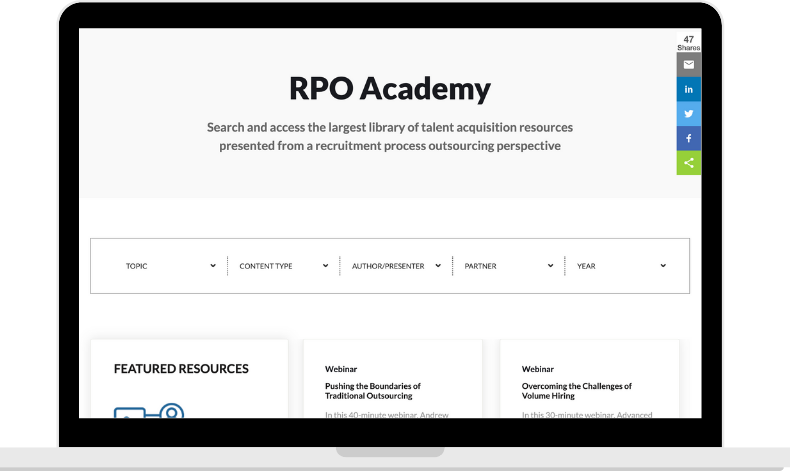-min.jpg?width=800&height=533&name=iStock-1196912174%20(1)-min.jpg)
Mergers and acquisitions (M&A) continue to energize the recruitment process outsourcing (RPO) industry. Private equity firms (PEs) now drive 40 percent of transactions. Sophisticated buyers control another 28 percent. Bill Filip, founder of Delancy Partners, spoke at a panel on M&A at the 2024 Annual RPOA Conference. Along with Filip, two industry veterans, Matt Corbett, founder of ZRG Embedded Recruiting, and Dwight Cooper, chairman of Hueman People Solutions, shared essential knowledge about preparation, execution, and value creation that determines M&A outcomes. Their combined experiences provide a roadmap for RPO leaders considering potential transactions. Joe Marino, Chief Growth Officer at Hueman, moderated the panel. This blog post provides a recap of their insights.
What’s in this article:
- Foundation: The Three Pillars of RPO Merger Preparation
- Value Creation: Understanding What Buyers Measure
- Understanding Valuation Dynamics: Lessons from Experience
- Private Equity vs Strategic Buyers: Understanding Different Approaches
- Modern Analysis Methods: How Technology and Scale Transform RPO Deal Evaluation
- Communication Strategy: Building Trust While Maintaining Control
- Managing Organizational Change: The Human Side of RPO Mergers
- Action Steps for RPO Leaders: Building a Foundation for Success
Foundation: The Three Pillars of RPO Merger Preparation
Successful RPO M&A needs three distinct and connected prep pillars. The pillars position companies for the best outcomes. RPO leaders can build a strong prep strategy by knowing how these pillars complement each other.
The first pillar focuses on comprehensive documentation and governance. Filip stated that PEs' growing influence improves prep standards. He said, "If you haven't been through it, you're not prepared yet." This preparation goes beyond just financial statements. It includes creating an advisory board to cover blind spots. Many RPO leaders overlook this, until it's too late.
The second pillar centers on financial leadership capabilities. Corbett stressed the need to start years before any deal. "Ensure your CFO has experience with private equity or public company acquisitions. "Embed financial controls and audit knowledge into the business." This pillar needs strong leadership and financial systems. They must meet sophisticated buyers' high expectations.
The third pillar demands clear strategic positioning. Cooper advised RPO leaders to make definitive market choices: "Decide whether you're a platform or an add-on. Because if you're strategic about how you design your business and pick one of those lanes, you can optimize your value." Companies that fail to commit to either position often sacrifice significant value by trying to appeal to both types of buyers.
Value Creation: Understanding What Buyers Measure
Buyers evaluate RPO companies through three distinct lenses that determine valuation multiples. Understanding these perspectives helps leaders focus improvement efforts for maximum impact.
Customer retention metrics provide the first crucial measure. Filip drew a parallel to software companies using subscriptions as a service (SaaS). Twenty-three percent of SaaS growth comes from expanding existing clients. He emphasized the need to "explain why you win and why you lose" - insights that demonstrate market understanding to potential buyers.
Market expertise forms the second value driver. Corbett stressed the need for authenticity in showing sector knowledge. He said, "Know your space, become an expert. Find a buyer who values that sector that they don't have." This expertise must extend beyond surface-level claims. Corbett noted how behavior during the M&A process reveals true capabilities: "Don't fake it. Don't make it up. The valuation isn't really decided until the end."
Management team depth creates the third crucial element. Cooper explained that buyer type affects which leadership layers matter most. "Platform sales need very built out, professionalized senior teams." Strategic buyers focus on middle management depth." This distinction helps RPO leaders prioritize team development based on likely exit paths.
Understanding Valuation Dynamics: Lessons From Experience
The valuation process reveals surprises even to experienced RPO leaders. Three critical insights emerge from the panel's combined experience with multiple transactions.
Equity retention often creates more value than maximizing the initial sale price. Cooper's experience proves instructive: "We kept 49 percent of the business. We probably left some dollars on the table at exit because we had a longer view." This strategy paid off remarkably––subsequent transactions generated 4.5 times return in 18 months, followed by 4.9 times return two years later. This pattern demonstrates how initial deal structure shapes long-term value creation.
Deal structure flexibility protects value through market changes. Corbett shared a key lesson from his first deal: "The banker didn't like how the buyers were behaving." They shifted the deal structure to cash, which turned out brilliant because their stock tanked over the next two years." This experience underscores why RPO leaders must remain adaptable throughout negotiations.
The human element often determines success, particularly when selling to larger organizations. Filip explained: "Finding that champion is really important. Half the time, it's finding the right person that will stick their neck out, or their career for a smaller business." These relationships prove crucial because larger organizations sometimes hesitate to acquire smaller companies.
Private Equity vs Strategic Buyers: Understanding Different Approaches
RPO leaders must understand how PE firms and strategic buyers approach transactions differently. This understanding shapes everything from preparation to integration planning.
Private equity conducts a deeper technical evaluation. Corbett viewed this positively: "The level of due diligence was actually much deeper than for a public company. If they're not asking deep, thoughtful, hard questions, that should be a huge red flag." These questions demonstrate serious partnership interest.
The fundamental difference lies in the operational approach. Filip explained: "Strategic guys are operators, so they look at operations. Private equity guys generally aren't operators - they're backing the team." This distinction affects how RPO leaders should prepare and present their businesses.
Common misconceptions about private equity can lead RPO leaders to overlook valuable opportunities. Cooper challenged these preconceptions through direct experience: "Private equity has a bad name. All private equity isn't created equal. We've had spectacular experiences. They were supportive, patient, and lots of people grew amazing careers."
Hear Cooper say why checking an PE's reputation with fellow founders will help you avoid grief. Listen to the full episode on the Time to Hire podcast.
Modern Analysis Methods: How Technology and Scale Transform RPO Deal Evaluation
The development of private equity has fundamentally changed how buyers evaluate RPO companies. Understanding these changes helps RPO leaders prepare for modern transaction requirements.
PEs’ increasing scale creates unprecedented growth opportunities. Corbett explained this transformation: "Years ago, PE might have a portfolio of 10, 20, 30 companies. Now you've got PEs with 500 companies." This scale changes the growth equation for RPO companies. RPO leaders can now find growth by using internal portfolio ties, not just external markets. Corbett noted, "You could grow your business just off their portfolio companies. You wouldn't even have to go into the marketplace anymore."
Pre-transaction planning has grown to match this increased scale. Cooper explained how buyers handle growth planning: "When companies want to buy you, they create a growth plan without your knowledge, even as they work with you." They want a really specific value creation growth plan." This dual-track planning process means RPO leaders must show clear paths to growth before serious discussions begin.
The revenue bridge analysis exemplifies this new rigor. Filip explained the detailed approach buyers now expect: "Start with last year, what's your churn? Then what's the near-term pipeline that you've got some paper on? What's the weighted pipeline?" Each step between current performance and future targets requires specific, quantifiable support. This analysis helps buyers and sellers align on realistic growth expectations before pursuing detailed discussions.
Communication Strategy: Building Trust While Maintaining Control
The timing and approach to M&A communications create complex strategic decisions. Three distinct perspectives from the panel reveal how successful RPO leaders navigate these challenges.
Trust becomes the determining factor in communication timing. Cooper advocated for earlier transparency than tradition suggests: "Trust is everything with your team. We let our senior management team under the tent really early, probably a lot earlier than others would." This approach maintains the trust built through years of working together. However, Cooper stressed staged disclosure: "We held conversations in confidence initially to avoid unnecessary drama."
Information flow often forces communication decisions. Filip explained why waiting too long creates risks: "If people hear from a third party, that's when things get nervous." This reality urges leaders to use controlled communication in talks, especially in management meetings with potential buyers.
Company culture shapes effective communication strategy. Corbett described how their established values drove timing decisions: "We had spent 10 years building a culture of brutal transparency (HIT: honor, integrity, and trust.) If we don't tell our team, we're being complete hypocrites." This cultural alignment helped maintain team engagement through the transaction process.
Managing Organizational Change: The Human Side of RPO Mergers and Acquisitions
The success of RPO M&A ultimately depends on how well organizations manage the human dynamics of change. The panel found three connected parts of change management that affect transaction results.
Understanding personal financial concerns emerges as the first crucial element. Corbett explained that employees view M&A announcements very personally. "After a transaction, people create imaginary stories in their minds about what's happening." They start to go into crisis mode - what's going to happen to my mortgage, my kids' school payments, my boat payment?" Leaders must address individual concerns before employees can engage with organizational goals. This is due to a natural tendency to personalize change.
The scope of change communication must extend beyond internal teams to include all stakeholders. Filip emphasized this broader perspective: "You also have to communicate to clients and partners what's going to happen, even just when you're taking private equity for the first time." This message has a strategic purpose. It helps stakeholders see how changes will improve their service and create new collaboration opportunities. As Filip noted: "Generally the message and reality shows how it helps them become a better client or partner."
Perhaps most critically, RPO leaders must protect the core elements that created their company's success. Cooper warned of the most common value destruction pattern: "The biggest mistake acquirers make is they don't protect the things that have made the business they're buying great." Buyers have this arrogance about themselves, and they wash out millions of dollars of value in the first 90 days." Preventing this value loss requires close work between buyer and seller. They must identify and preserve key value drivers while planning integration steps.
Action Steps for RPO Leaders: Building a Foundation for Success
The combined insights from the panel create a clear roadmap for RPO leaders approaching potential or considering future transactions. This framework helps ensure comprehensive preparation across all crucial dimensions.
Begin preparation years before any anticipated transaction. First, build strong financial leadership. Do this through direct private equity or public company experience. Corbett emphasized that this prep must be part of the org's foundation: "Build financial controls and audit understanding into the fabric of the business."
Make clear strategic choices about market positioning. Cooper's advice helps RPO leaders focus resources. He said, "If you're strategic about your business design and pick one of those lanes, you can optimize your value." It is about choosing between platform and tuck-in positioning." This choice shapes everything, from operations to valuation.
Develop multiple dimensions of growth to demonstrate value to sophisticated buyers. Filip's emphasis on proving multiple paths to success remains crucial: "You need multiple dimensions to your growth model. You have to have one or two ways to win." Document these growth paths through detailed revenue bridge analysis that shows exactly how you'll achieve targets.
Build trust through transparent communication while protecting confidentiality. The timing of merger communications requires careful calibration based on your organization's culture and values. Consider Cooper's early disclosure to senior leaders. Keep some details confidential at first.
Most importantly, protect the core elements that drive your business value through the transition. Cooper's warning about value destruction in the first 90 days shows the need for intense collaboration between the buyer and seller. It must focus on identifying and preserving the attributes that created success.
The RPO mergers and acquisitions market continues to grow, driven by increasingly sophisticated buyers and increasing deal complexity. Leaders who grasp these dynamics and prepare, succeed. Their firms benefit from deals that help companies and workers through the transition and beyond.






-min.jpg)







